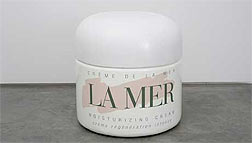While John Waters is best know for creating transgressive movies like the cult classic Pink Flamingos, since the early 1990s, he has also been making visual artworks. His largely photo-based pieces typically exhibit a piquant, satirical sensibility that will be familiar to fans of his filmic oeuvre. Often using appropriated or altered film stills, Waters’ artworks, like his films, humorously subvert the proscriptive norms that both Hollywood and American culture perpetuate. In Rush, his fourth solo exhibition at Rena Bransten Gallery, Waters shows off his campy chops, but also, surprisingly, offers a glimpse behind his hallmark irony at a more personal and idiosyncratic vision of the world.
The numerous two-dimensional works scattered around the exhibition’s main room traffic in Waters’ most enduring themes. In the twelve altered film stills that compose A Passion for Audrey (2010), Waters pokes fun at crude celebrity adoration by digitally adding hickies to images of the actress Audrey Hepburn. In image after image, the tawdry marks mar Hepburn’s elegant neck, and in the final image — a laugh-out-loud coda — her neck is concealed by a nun’s habit, but hickies cover one entire side of her face. Hollywood Smile Train (2010) similarly makes celebrities ugly, but not through the actions of their admirers. By giving stars like Alfred Hitchcock, Elizabeth Taylor, and Tom Cruise, cleft palettes Waters, not only mutilates their iconic visages, but juxtaposes the powerful privilege they enjoy with the plight of children whose families are too poor to afford reconstructive surgery. Necro (2009) engages fame’s eagerness to reach beyond the grave through a series of images in which actors lie in coffins playing dead. These portraits are both humorous and eerie, comically pre-staging each star’s eventual demise. The actors are not really dead, but ironically, lying still with eyes closed requires that they not act.This inaction reduces each actor to no more than their basic corporeal presence — an iconic mask that continues to convey their identity and celebrity even in death.
These themes of attraction, revulsion, and celebrity continue in the three strangely proportioned sculptures in the main gallery. La Mer (2009) is a grossly enlarged tub of La Mer moisturizer. The enormous container of expensive cream nicely mirrors our culture’s inflated obsession with beauty and the excessive length we will go to achieve it. Rush (2009), a similarly enlarged bottle of a cheap, aromatic sex drug, takes cultural excess in a more lewd direction. The bottle is open, on its side, and has disgorged a disturbing, brown puddle of liquid. With an oil spill still spreading in the Gulf of Mexico, this work’s subtle politics have become all the more poignant. Decorative (2009) offers up an oversized Combat cockroach bait embossed with “DECORATIVE” instead of “COMBAT.” It is unclear whether this oversized, poison-filled trap is intended to kill off any decorative aspect that might inadvertently sneak into the show, or simply give monumental visibility to the unexpected formal beauty of this pest control device. Control (2009) plays with scale but otherwise is quite different from the three object-based sculptural works. It depicts a life-sized kneeling replica of Ike Turner manipulating a diminutive marionette of Tina Turner. The meaning is both overt and simultaneously cryptic. Waters, a big Tina Turner fan, was also a puppeteer as a child, and it is unclear if Ike is really holding the strings or if Waters is.
The sculptures and various image-based works staged in Rena Bransten’s main gallery exemplify Waters’ visual art career to date. However, it is the more sedate photographic series in the smaller back gallery that warrants a closer look. These fifteen modestly-scaled photographs, all entitled Pecker Still Life (2010) were taken by Waters on the set of his 1998 film Pecker, a comedy about the uncomfortable effect fame has on a photographer, his family, and the subjects of his photographs. Rather than Waters’ usual meditations on structures of celebrity, normativity, desire, and power, these photographs capture idiosyncratic moments of subtle beauty that Waters came across during the shoot. Far from campy, their deadpan arrangements of power cords, drink coolers, director’s chairs, and monitors, exude a quiet solemnity disturbed only fleetingly by glimpses of wry humor. Their spare aesthetic seems at odds with Water’s other more ribald work, but in concert the two pair nicely. Waters has long played with the proscriptive messages that Hollywood constructs. In this new body of work he seems to ask us to look through the cracks in that facade into a world that is not wacky but banally weird, precisely because it hasn’t been scripted.


